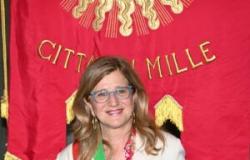VENICE – The Japanese artist Mariko Mori (Tokyo, 1967) inaugurated his impressive work in Venice Peace Crystalan installation site-specific which invites us to reflect on our common humanity. The work, 165 centimeters high and made in quartz glassstands majestically in the garden of Palazzo Corner of Ca’ Granda.
A hymn to peace and life
Peace Crystal represents the human body as a container of the eternal soulwhich crosses the life, death and rebirth. The slender form of the work, which resembles a crystal, recalls human evolution, the moment in which human beings became upright. This crucial event, according to Mori, led to the development of intelligence and spirituality.
Mariko Mori reveals: “In 2016 I had a profound and transformative encounter with a great light. This revelation made me realize that we are all blessed and deeply loved in every moment of our lives. Our existence is a testament to our interconnectedness, signifying that we are part of a greater whole. The Crystal of Peace (Peace Crystal) symbolizes this unity, connecting the heavenly and the earthly and embodying the eternal soul within us. I am deeply honored to present my fourth project in Venice, a city very dear to me, in the enchanting embrace of this magical garden.”
A work illuminated by the energy of the sun
The Peace Crystal lighting is a fundamental element of the work. A external solar collector collects light and passes it through quartz glass optical fibers, transmitting real light inside the work. This light gives Peace Crystal an aura of life and vitality, symbolizing the energy that animates the universe and our very existence.
A dialogue between contemporary art and historical heritage
Peace Crystal is a work that fits perfectly into the Venetian context. Its location in the garden of Palazzo Corner della Ca’ Granda, a place rich in history and culture, creates a dialogue between contemporary art and the historical heritage of the city.
A work that invites reflection
Peace Crystal it is a work that invites us to reflect on our common humanity, our connection with the universe and our responsibility towards the planet. The work of Mariko Mori is a message of peace, unity and hope for a better future.
The work can be visited for free until October 7, 2024upon mandatory reservation via the Bloomberg Connects app or at the Palazzo Diedo ticket office.
The inauguration of Peace Crystal it was a great success, with the participation of numerous authorities and personalities from the world of culture. The work has already received a great appreciation from the publicwho has the opportunity to admire a unique and evocative work of art.
Biography of Mariko Mori
Mariko Mori was born in Tokyo in 1967. From a young age he was interested in art and fashion, studying design at the Bunka Fashion College in Tokyo. In the 80s she worked as a model, while she began to develop her artistic research. In 1989 she moved to London to study at the Byam Shaw School of Art and Chelsea College of Art and Design.
Influenced by European pop art and Japanese culture, Mori creates works that explore themes such as technology, spirituality and globalization. His works often include multimedia elements, such as video, photography and performances. Mori is considered one of the pioneers of digital art and has exhibited her works in some of the most important museums in the world.
After the Venice exhibition, Peace Crystal it will be donated to Ethiopia and permanently installed in a cave, thus honoring the origins of man which begin in Ethiopia, the cradle of evolution for over six million years.
Vademecum
Mariko Mori, Peace Crystal
Palazzo Corner garden of Ca’ Granda, Venice
From 16 June to 7 October 2024
From Thursday to Monday, from 11am to 7pm




